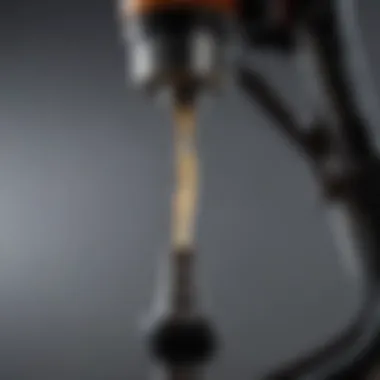Hudson Battery Powered Backpack Sprayer Review


Intro
The advancement of technology in agricultural practices is fundamental to achieving efficiency and sustainability. Among the various innovations is the Hudson battery-powered backpack sprayer, which has gained traction among farmers and horticultural enthusiasts. This instrument facilitates precise application of pesticides, herbicides, and fertilizers while minimizing labor-intensive tasks. As modern agriculture continues to evolve, understanding the mechanics behind such tools becomes crucial. This article aims to explore the design, functionalities, and benefits of the Hudson sprayer, while examining its impact on various agricultural contexts.
Key Concepts and Terminology
Definition of Terms
Before diving deeper, it is essential to clarify pertinent terms related to the Hudson backpack sprayer:
- Backpack Sprayer: A portable sprayer worn on the back, allowing for ease of use and mobility when applying liquids.
- Battery-Powered: Referring to devices operated by rechargeable batteries, as opposed to traditional gasoline or manual pumps.
- Spray Volume: The quantity of liquid that can be dispensed over a defined area, impacting coverage and efficiency.
Overview of Relevant Practices
The use of backpack sprayers has become a standard practice in various fields by reducing time and effort involved in spraying tasks. Modern models incorporate advanced technologies that enhance precision and reduce environmental risks, making them ideal for small-scale farms and gardens. Understanding these practices allows users to maximize the effectiveness of their equipment.
Current Trends and Innovations
Latest Research and Developments
Recent advancements have led to the integration of smart technologies into backpack sprayers. These innovations focus on improving user experience and environmental considerations. For instance, automated systems that adjust spray rates based on terrain or crop type are now becoming more common. These adaptations ensure optimal application rates, thus limiting waste and potential runoff into surrounding ecosystems.
Emerging Technologies and Tools
As the agricultural industry embraces technological solutions, newer models are incorporating features such as pressure gauges, electronic control systems, and even GPS technology to aid in accurate application. Hudson's sprayer exemplifies this trend, effectively responding to the needs for accuracy and ease of use in farming tasks.
Practical Applications
Step-by-Step Guides
Using the Hudson battery-powered backpack sprayer effectively requires a simple yet thorough process:
- Preparation: Begin by filling the tank with the required solution, ensuring to follow manufacturer guidelines.
- Battery Check: Confirm the battery is fully charged to ensure uninterrupted operation.
- Adjust Settings: Depending on the terrain and crop type, adjust the nozzle settings for appropriate spray width and volume.
- Application: Wear protective gear and begin spraying, moving at a steady pace to ensure consistent coverage.
Troubleshooting Common Issues
Mistakes can happen even with advanced equipment. Common problems include:
- Inadequate Spray Coverage: Check the nozzle and ensure it is not clogged. Adjust spray settings as needed.
- Battery Drain: If the sprayer ceases to function, verify battery charge and connections.
"Using modern sprayers such as Hudson's significantly reduces the amount of chemicals used, promoting more sustainable practices."
By becoming familiar with the Hudson battery-powered backpack sprayer, users can optimize their spraying tasks, contributing to effective resource management in agriculture.
Prelude to Hudson Battery Powered Backpack Sprayer
The Hudson battery powered backpack sprayer represents a significant advancement in agricultural spraying technology. Its relevance lies in the industry’s growing demand for efficient, environmentally friendly tools that reduce the physical strain on users while maximizing productivity.
Overview of Backpack Sprayers
Backpack sprayers are essential for both commercial and amateur horticulturists. These devices offer the mobility and capacity required to apply liquids over a broad area without the need for bulky machinery. A battery powered model like the Hudson sprayer eliminates the dependence on fuel, resulting in cleaner operation. This is important as sustainability becomes a critical concern in modern agriculture.
Key advantages of backpack sprayers include:
- Portability: Users can easily maneuver the sprayer in various terrains, enhancing accessibility.
- Reduced Fatigue: The ergonomic design of a backpack sprayer distributes weight evenly, decreasing user fatigue, especially during prolonged use.
- Versatility: They can be employed for a variety of applications such as pesticide, herbicide, and fertilizer application.
Innovation in Sprayer Technology
The infusion of battery technology into the design of sprayers signifies an innovative leap. Traditional gas-powered sprayers have been the standard for decades, but they often emit harmful fumes and require more maintenance. Battery powered options, like the Hudson sprayer, use electric pumps that allow for precise control and consistent pressure. This results in a more efficient application of liquids.
Several notable innovations include:


- Smart Controls: Some models feature smart systems that provide real-time feedback on battery life and pump pressure, optimizing the user experience.
- Improved Battery Life: Recent improvements in lithium-ion batteries have increased the runtime, making them suitable for larger jobs without frequent recharging.
- Lightweight Materials: The use of durable but lightweight materials has improved the design, making them easier to carry and handle.
In summary, the Hudson battery powered backpack sprayer is not just a tool but a modern solution that meets the evolving needs of the agricultural sector. As we explore the technical specifications and operational aspects of this sprayer, we will see how these innovations translate into practical benefits for users.
Technical Specifications
Understanding the technical specifications of any equipment is critical. This section provides valuable insights into the Hudson battery-powered backpack sprayer's fundamental components. Each specification informs users about the sprayer's performance, usability, and suitability for varied applications. A profound grasp of these variables ensures that potential buyers can make well-informed decisions according to their specific needs.
Battery and Power Details
The battery is the cornerstone of the Hudson backpack sprayer. It utilizes a lithium-ion battery, known for its reliability and efficiency. Generally, lithium-ion batteries hold charge longer and perform better under heavy use compared to traditional batteries. The voltage rating is typically between 18-24 volts. This voltage range delivers a powerful, steady output, which results in a consistent spraying performance.
Moreover, the power capacity affects how long the sprayer can operate before needing a recharge. Most Hudson sprayers offer a run time of approximately 3 to 5 hours on a full charge, which is suitable for extensive agricultural applications. Users should consider their spraying needs and choose a model with a capacity that supports their operational requirements. The ability to recharge quickly is essential for minimizing downtime in the field. With recharge times around 2 hours, users can keep the sprayer ready for continuous use without lengthy interruptions.
Tank Capacity and Weight
The tank capacity of the Hudson sprayer usually ranges between 4 to 6 gallons. This capacity is significant as it determines how much liquid can be carried, impacting the number of trips to refill. For larger farming operations, a bigger tank means fewer breaks, increasing work efficiency.
Weight is also a crucial factor. An empty Hudson sprayer weighs around 10 to 12 pounds. When filled, the weight can become considerable, which may affect maneuverability and comfort during extended use. Comfort features are vital, especially for users who operate sprayers for long periods. An appropriate balance between tank capacity and weight can lead to better user experience, ensuring less fatigue and improved efficiency in the field.
Materials and Durability
Durability is key in any agricultural equipment. The Hudson backpack sprayer is typically constructed from high-density polyethylene. This material is resistant to corrosion and handling, ensuring longevity despite exposure to various chemicals such as pesticides and herbicides. Its robust design minimizes the risk of leaks and breaks, offering greater reliability for intense operations.
Furthermore, the straps and back support are designed to be ergonomic. The materials used for these components are often reinforced to withstand wear and tear throughout routine use. A durable construction is essential as it reflects the sprayer’s ability to withstand challenging working conditions over time. Investing in high-quality materials ensures that the sprayer remains operational for many seasons, making it a more economical choice in the long run.
"Selecting equipment based on its specifications is crucial for both performance and longevity in agricultural applications."
Operational Efficiency
Operational efficiency is a critical factor when evaluating sprayers, particularly in the context of the Hudson Battery Powered Backpack Sprayer. This efficiency encompasses several elements that collectively contribute to the sprayer's overall performance, affecting not only productivity but also user satisfaction and environmental considerations. Understanding these components helps farmers and horticulturalists maximize their investment in this technology, ensuring they achieve optimal results while minimizing waste.
Spraying Mechanism
The spraying mechanism of the Hudson backpack sprayer is designed for precision and adaptability. It utilizes a diaphragm pump that generates consistent pressure, which is essential for even distribution of various liquids, including pesticides, herbicides, and fertilizers. This feature is crucial, as uneven spraying can lead to inadequate coverage, resulting in ineffective pest control or nutrient delivery.
The nozzle options provided with the sprayer allow users to adjust the spray pattern according to specific tasks. For instance, a fine mist may be needed for delicate plants, while a broader spray may be more appropriate for larger areas. The ability to switch quickly between these settings enhances operational efficiency, as it reduces downtime for adjustments during fieldwork. Furthermore, the ergonomic design of the sprayer allows for easy handling, minimizing fatigue and enabling longer working hours without compromising performance.
Coverage Area and Pressure Settings
Coverage area and pressure settings play a vital role in the practical application of the Hudson sprayer. Users can expect varied coverage based on the chosen nozzle and pressure selection, allowing them to customize settings according to their specific agricultural needs. The sprayer is designed to cover substantial areas efficiently, making it suitable for both large-scale farms and smaller garden setups.
Effective pressure settings are crucial as they determine the droplet size and distribution pattern. Higher pressures can create finer droplets, ideal for windy conditions, preventing drift loss. Conversely, lower pressures can be used for thicker applications where coverage is prioritized. An understanding of these parameters helps users apply the right amount of product at the right pressure, thus maximizing efficacy and minimizing waste.
Run Time and Recharge Time
Another significant aspect of operational efficiency is the run time and recharge time of the Hudson Battery-Powered Backpack Sprayer. Equipped with a robust battery, this sprayer offers extended run times, allowing for prolonged use without frequent interruptions. Depending on the application and settings used, farmers can complete large tasks without needing to stop for charging.
Charge times are also competitively short, enabling users to return to work quickly. The balance of run time to recharge time is crucial for maintaining workflow on busy agricultural days. This design consideration ensures that users spend more time applying treatments and less time waiting for their equipment to recharge, enhancing overall productivity in their operations.
"Understanding the dynamics of operational efficiency in sprayers like the Hudson can significantly impact productivity and effectiveness in agricultural practices."
By focusing on features such as a reliable spraying mechanism, adjustable coverage area, and efficient battery management, the Hudson Battery Powered Backpack Sprayer stands out as a capable tool for modern agriculture. Evaluating these elements allows users to consider how the sprayer can meet their specific needs while optimizing their resources in the field.
User Experience
User experience is a cornerstone of evaluating the Hudson battery-powered backpack sprayer. As this device is designed for prolonged use in agricultural settings, understanding how it impacts user comfort, efficiency, and maintenance is essential. A positive user experience can lead to increased productivity and satisfaction, which ultimately affects the overall success of agricultural practices.
Comfort and Ergonomics
Comfort is a significant factor when using the Hudson backpack sprayer. Its design considers the physical demands placed on users during operation. The adjustable shoulder straps and back support are crucial features. They help distribute weight evenly, reducing fatigue over long spraying sessions. Users report that the padding in the straps adds to comfort, allowing for extended use without strain.


Moreover, the ergonomic shape of the tank and nozzle facilitates a natural hand position during spraying. This design minimizes discomfort and enhances control over the spraying process. Comfortable equipment can lead to better results since users are less likely to rush or make mistakes when they feel at ease in their tasks.
Ease of Use and Maintenance
Another essential aspect of the user experience with the Hudson sprayer is ease of use. This device features a user-friendly design that does not require extensive training. Most users find that getting the sprayer ready for action takes only a few minutes. The intuitive controls allow for quick adjustments in spray patterns and pressure, which is beneficial when switching between different applications.
Additionally, maintenance is straightforward. The design incorporates removable components for easy cleaning. Regular maintenance helps in maintaining the longevity of the sprayer and ensures efficient performance. Users appreciate how easy it is to keep the sprayer in optimal condition, as this reduces downtime and enhances productivity.
Noise Levels and Environmental Impact
The operational noise levels of the Hudson backpack sprayer are relatively low compared to gas-powered alternatives. This feature is especially valuable in residential areas or sensitive environments, where excessive noise can be disruptive. Users often mention that less noise contributes to a more pleasant work atmosphere.
In terms of environmental impact, the Hudson battery-powered sprayer offers advantages as well. It operates quietly and produces no harmful emissions during its use, unlike some gas-powered sprayers. This makes it an appealing choice for environmentally conscious farmers who want to minimize their footprint while maximizing efficiency.
"The Hudson sprayer is a game changer for those who prioritize comfort and efficiency. You won't just get the job done; you'll enjoy doing it."
In summary, the user experience of the Hudson battery-powered backpack sprayer plays a vital role in its overall effectiveness. Comfort, ease of use, and lower environmental impact are crucial considerations for potential users. These factors contribute to making this sprayer a compelling choice in the market.
Applications in Agriculture and Horticulture
The Hudson Battery Powered Backpack Sprayer offers various applications that are crucial in agriculture and horticulture. Understanding how to efficiently utilize this sprayer can have significant impacts on crop yield and health. Its design caters to specific needs in pest control, fertilization techniques, and herbicide application, which will be discussed below.
Pest Control
Pest management is a top priority for farmers and horticulturists. The Hudson sprayer excels in this area due to its ability to deliver treatments precisely where needed. This ensures that chemicals are targeted effectively, reducing waste and enhancing effectiveness.
- Targeted Application: Users can adjust the sprayer's nozzle settings for both fine and coarse sprays, allowing for flexibility depending on the pest type.
- Reduced Chemical Use: Using a battery-powered sprayer decreases the risk of over-spraying, which minimizes chemical usage and lowers costs while being safer for the environment.
- Application Timing: The portability of the backpack sprayer allows for timely applications, which is crucial for effective pest control. Treatments can be applied right when pests are detected, preventing potential crop damage before it happens.
A research from Encyclopedia Britannica highlights the significance of proper application in pest management, reinforcing that efficiency directly correlates with reduced pest-related losses.
Fertilization Techniques
Efficient fertilization techniques are essential to ensure optimal growth of crops. The Hudson sprayer allows for precise nutrient delivery, aiding in achieving the best results.
- Granular and Liquid Fertilizers: The sprayer accommodates both types of fertilizers, giving users flexibility in their choice. This dual function simplifies the process, as there is no need to switch equipment.
- Adjustable Flow Rates: Farmers can manipulate the flow settings to control the amount of fertilizer being applied. This aids in tailoring applications to soil or crop requirements, optimizing resource use.
- Reduced Runoff Risk: By allowing slow and steady application, the backpack sprayer lowers the chance of runoff, which commonly occurs with fast applications. This also helps in preserving the health of nearby water sources.
Implementing effective fertilization methods leads to improved soil health, creating a sustainable environment.
Herbicide Application
Herbicides are critical in maintaining healthy crops, especially in the presence of competing weeds. The Hudson backpack sprayer plays a vital role in this management process.
- Selective Targeting: The sprayer's precision helps in applying herbicides only where necessary, preventing damage to desired crops and benefiting overall yield.
- User Control: With user-friendly controls, operators can quickly adjust herbicide concentration and application rates. This ensures that the right amount is used every time, reducing waste and enhancing effectiveness.
- Environmental Considerations: The enclosed application ensures that there is less drift, meaning less impact on surrounding ecosystems. This aspect is particularly beneficial in organic farming practices.
"Proper herbicide application is essential in sustainable agriculture, allowing for weed management without compromising crop health."
Incorporating the Hudson Battery Powered Backpack Sprayer into agriculture practices illuminates a more effective path forward. Its applications are versatile and environmentally friendly, enhancing overall operational efficiency in pest control, fertilization, and weed management.
Comparative Analysis
The comparative analysis of different types of sprayers is crucial for understanding the strengths and weaknesses of each option in the context of agricultural practices. This section provides valuable insights into how the Hudson Battery Powered Backpack Sprayer performs when compared to gas-powered sprayers and traditional sprayers. Evaluating these components helps in making informed decisions, allowing users to choose the most suitable equipment for their specific needs.
Battery Powered vs. Gas Powered Sprayers
Battery-powered sprayers, like the Hudson model, offer several advantages over their gas-powered counterparts. First, they are much quieter during operation. This can be beneficial in built-up areas or when working near sensitive wildlife. Additionally, battery-powered options tend to have lower emissions, which is an important consideration for environmentally-conscious farmers.
In terms of maintenance, battery-powered sprayers may require less upkeep since there are no moving parts related to engine operation. They also eliminate the need for fuel storage and mixing, reducing potential hazards on the farm. Battery technology has improved over the years, enabling longer run times that compete with gas options. Given these advantages, more users gravitate towards battery-powered sprayers.
However, gas-powered sprayers often provide more power, especially needed for larger spraying tasks. They usually have a longer operational time on a single tank compared to the average battery charge. Thus, for heavy and continuous spraying activities, gas-powered models might still hold an edge. Farmers need to consider the scale of their operations and environmental factors when choosing between these two types.
Backpack Sprayers vs. Traditional Sprayers


Comparing backpack sprayers to traditional wheeled sprayers highlights significant differences in usability and application efficiency. Backpack sprayers, such as the Hudson model, are designed for ease of movement. This is particularly useful in areas where terrain is uneven or obstacles are present. The portability of backpack sprayers allows users to easily access hard-to-reach spots, making them ideal for precise applications.
Traditional sprayers, while effective, often require a larger space for maneuvering. Their bulk can be a disadvantage in smaller farms or intricate garden layouts. Nevertheless, traditional sprayers typically have a larger tank capacity, which can minimize the frequency of refills during extensive spraying tasks. Users must weigh this factor against the convenience and practicality of backpack sprayers.
Moreover, backpack sprayers often allow for more flexibility in pressure settings, enabling users to adjust the application according to the specific needs of different plants and pests. They can be less tiring to use for extended periods since the weight is distributed on the back. Consequently, the choice between a backpack sprayer and a traditional model should consider considerations like the size of the area being treated and specific task requirements.
Cost Implications
The expenditure associated with agricultural tools can significantly influence modern farming practices. Therefore, understanding the cost implications of the Hudson battery-powered backpack sprayer is essential for both individual farmers and horticulture professionals. This section will dissect various financial factors at play, including the initial investment and potential long-term savings, as well as specific budget considerations that arise for small farms.
Initial Investment vs. Long-Term Savings
When purchasing a Hudson battery-powered backpack sprayer, the upfront cost can be steeper than certain gas-powered alternatives. The pricing reflects advanced battery technology, ergonomic design, and efficient spraying mechanisms.
However, assessing only the initial cost does not provide a complete picture. The savings in fuel, maintenance, and operational efficiencies over time can elevate this choice. Proper battery management within the Hudson sprayer reduces operational costs, making it a fiscally sound option in the long term.
For example, the absence of fossil fuel costs can lead to considerable lifetime savings. Additionally, quality batteries can last multiple seasons, minimizing replacement costs.
"Investing in modern, efficient tools like the Hudson sprayer may seem costly at first, but they often yield significant savings down the line."
Budget Considerations for Small Farms
Small farms often operate on tighter budgets, which makes financial decisions critically important. The Hudson backpack sprayer offers a compelling blend of cost efficiency and functionality.
Here are a few budget considerations for small farm operations:
- Initial Costs: Although the price point might initially raise concerns, purchasing a reliable sprayer can prove valuable in achieving better crop yields.
- Operational Costs: Battery-powered equipment generally incurs lower ongoing costs than gas-powered alternatives. This aspect can alleviate some financial burden over time.
- Versatility: The Hudson sprayer's design allows it to be used for various tasks, including pest control and fertilizing, further justifying the investment by minimizing the need for multiple devices.
- Durability: Its materials and durability contribute to long-term savings, as fewer replacements and repairs will be necessary.
By carefully evaluating both immediate financial impacts and long-term expectations, small farms can make informed decisions that support sustainable agricultural practices.
User Feedback and Reviews
Understanding user feedback and reviews is crucial when considering the Hudson battery-powered backpack sprayer. This feedback provides valuable insights into the actual performance of the sprayer in real-world conditions, which can differ significantly from manufacturer specifications. Reviews highlight both the strengths and weaknesses of the product, helping potential buyers make informed decisions based on the experiences of their peers. Also, the accumulation of user reviews can impact the product's reputation and future development.
User feedback serves several important functions:
- Insight into Product Performance: Users share their experiences regarding efficiency, reliability, and usability. This information is vital in assessing how well the sprayer meets its intended purposes, especially in varied agricultural contexts.
- Identification of Common Issues: Feedback often highlights recurring challenges faced by users. Understanding these challenges can assist future buyers in anticipating potential difficulties and help manufacturers make improvements.
- Evaluation of Customer Support: Reviews may assess the responsiveness and quality of support provided by Hudson for warranty claims or product issues. A well-received customer service experience can influence purchasing decisions positively.
Customer Satisfaction Levels
Customer satisfaction with the Hudson battery-powered backpack sprayer tends to vary based on individual experiences. Many users appreciate the convenience and efficiency provided by this product. High satisfaction levels are often reported when users notice its effectiveness in achieving even distribution of pesticides or fertilizers.
Key aspects leading to customer satisfaction include:
- Ease of Use: Many feedbacks mention how user-friendly the sprayer is. The controls are intuitive, which allows for quick adjustments while in the field.
- Lightweight Design: Users often highlight the comfortable design, making it easier to carry during extended periods of use. This attribute is particularly appreciated by those who work on larger plots.
- Battery Life: A common positive note is the battery life, which is sufficient for most tasks without needing frequent recharges. Users find this particularly advantageous in busy periods when efficiency matters.
Nevertheless, it is important to note that while satisfaction levels are generally high, they are not universally positive.
Common Challenges Experienced
Even with overall satisfaction, customers have reported challenges with the Hudson battery-powered backpack sprayer. Knowing these common issues can prepare potential buyers for what to expect:
- Durability Concerns: Some users have mentioned that certain components show signs of wear more quickly than anticipated. Reviews suggest being cautious with the nozzle, which can clog and require constant cleaning.
- Limited Coverage Area: While the battery life is praised, some users feel that the coverage area the sprayer can efficiently manage is less than ideal for larger fields. This limitation may necessitate multiple refills, which can be disruptive to workflow.
- Pressure Control Mechanical Limits: There are instances where users mention that adjusting pressure can be somewhat cumbersome. The pressure settings are not as flexible as some users would prefer, which could hinder precise applications.
In summary, while the feedback on the Hudson battery-powered backpack sprayer is largely favorable, understanding the nuances of user experiences can greatly benefit potential customers. Being informed about both strengths and weaknesses will lead to better decision-making and optimize the agricultural value derived from this sprayer.
Finale
The significance of the conclusion in this article lies in summarizing the key insights and findings regarding the Hudson battery-powered backpack sprayer. Throughout the discussion, we explored its technical specifications, operational efficiency, and user experiences, which all contribute to understanding this product's place within modern agricultural practices.
One major element to consider is the sprayer's efficiency in various applications, such as pest control and fertilization. This is crucial for farmers and horticultural enthusiasts seeking to enhance productivity without compromising on comfort and ease of use. The feedback from users reflects a consensus on how these design choices lead to better outcomes in real-world scenarios.
Moreover, it is evident that the Hudson backpack sprayer offers substantial benefits over traditional models. By analyzing both battery-powered and gas-powered alternatives, we shed light on how advancements in technology can improve operational effectiveness while also being more environmentally friendly. This aspect is increasingly relevant as agricultural practices evolve towards sustainability.
"Making informed decisions about sprayer technologies is pivotal for optimizing both yield and resource management."
In terms of considerations, it is vital for potential users to weigh initial costs against long-term savings. Understanding the maintenance and operational costs can guide farmers and horticulturists in making an investment that serves their needs for years ahead.
In summary, effectively grasping the concluding insights regarding the Hudson battery-powered backpack sprayer allows for a clearer perspective on its advantages and operational role in contemporary agriculture. This aids in understanding its contribution to not just immediate agricultural tasks but also the broader context of sustainable farming practices.







